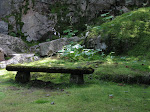Egads, peonies, tulips . . . bulbs! I forgot all about the new 'Sarah Bernhardt' peonies tucked away in the back of my basement refrigerator. And the sweet little glory-of-the-snow (Chionodoxa ssp.) and snowdrop (Galanthus nivalis) bulbs that were going to greet me with a nodding smile on a day just like today. The ground is frozen solid. Even if I were brave enough to be outside longer than 8 1/2 minutes (and I'm a winter wimp), there's no way any holes can be dug.
Fortunately, there are options for feeble-minded, middle-aged women with too many kids and dogs and jobs.
Galanthus nivalis
The snowdrops and glory-of-the-snow bulbs are not going into their intended home under our mature maple tree until mid-March. Yes, past bloom time. But the bulbs are still firm and not dry, so they will survive if I plant them as soon as I can dig. They'll grow a little, settle into their new home, then go dormant. I will have to wait for their winter greeting until next year.The tulips I can enjoy this year, but they will be late. I'll dump the dirt out of my larger containers, then refill with (unfrozen) potting soil and plant now with a covering of pansies for color to last until the tulips bloom.
Paeonia 'Sarah Bernhardt'
The peonies are a long shot. They don't like to be moved, and like to be planted in early fall so they can get established before winter (that is, if you want them to bloom). They also like to be planted in deep soil (but not deeply in the soil, but in soil that has been dug and amended wider and deeper than they are planted). So, I'll use my largest terra cotta containers that I'll fill with half soil and half compost, mixing in a little slow-release fertilizer (I like Osmocote). Peonies should be planted deeply enough so that the "eyes" or buds are about 2 inches under the soil when covered. My hope is that they will survive, green up and then transplant without dying. Stay posted for pictures of the peonies in transition.I'm really glad I didn't get a manicure last weekend!






